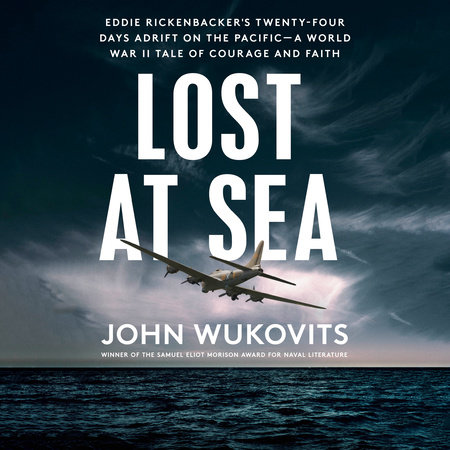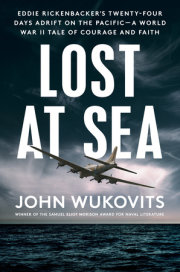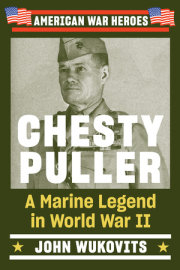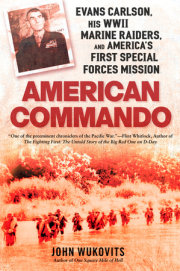CHAPTER 1
"He Has Cheated the 'Grim Reaper' About as Often as Any Living Man"
1890 to 1940
They would soon be dead. How could they think otherwise? The eight men, ranging in age from twenty-two to fifty-two, alone on the ocean, crammed into three tiny rubber rafts, had drifted for so long that they could not be certain where they were or how long they had been afloat. In a day or two, at most, they would undoubtedly join the countless unlucky voyagers lost forever to the Pacific.
They had survived multiple challenges. Each day, the sun's glare bounced off the ocean surface to emit "billions of sharp splinters of light; no matter where one looked, it was painful." The blistering sun had so burned their skin that one of the group compared it to "being turned on a spit." They had prayed for nighttime's welcome relief, only to shiver in the dark from the chilling ocean swells that drenched them. "Daytimes we prayed for the coolness of the nights; nights we craved the sun," wrote one of the eight.
Men had lapsed into stupors, bobbing in the ocean with their mouths half open and fatigued heads drooping on sunburned chests. They had battled both extreme hunger and severe thirst, and had grimaced from constricted muscles caused by squeezing into rafts hardly big enough for two people, let alone three. "Our bodies, our minds, the few things we had with us were slowly rotting away." Intensifying their anxiety was that they would perish without a trace, denying family and other loved ones details that could help bring closure. They could hold on awhile longer, but eventually the Pacific would wield the upper hand.
Except for one, the eight men had led routine lives. They had attended school, dated girls, played baseball and football, and afterward commenced careers they hoped would bring long and pleasant lives. The one exception, however, enjoyed a lifestyle the others could only envy. His name dominated the nation's headlines, and he had packed more thrills into his fifty-two years than the other seven combined. He enjoyed fame as a race car driver, dated gorgeous women, and basked in the limelight of being the nation's preeminent hero of World War I. He had eluded death so often on the racetrack and in the skies that an adoring public believed nothing could stop him.
"No man of this living generation has seen death more closely and more often than Eddie Rickenbacker," wrote popular author W. L. White. "He has learned to look the Old Fellow right back in the eye, as one man to another, returning his steady gaze." Time magazine turned to legendary figures from ancient Rome in depicting Rickenbacker as a man whose core was built upon "a gladiator's indomitability."
In October 1942 eight men crafted a rousing saga at sea that inspired their fellow countrymen and enhanced the legend of a man who had long captured the nation's adulation.
"I Didn't Go to School-I Went to Work"
Eddie Rickenbacker's youth in Columbus, Ohio, provided few hints of the extraordinary path he would follow. In 1879 his father, William Rickenbacher (the last name contained the letter h until Eddie changed it later in life), joined tens of thousands of Europeans who sought a better life across the Atlantic than that offered by the hardscrabble existence prevalent in their native countries. William said goodbye to family and friends in the small village of Zeglingen, Switzerland, nestled in the foothills of the Jura Mountains, determined to join his uncle in Columbus and begin work as a railroad laborer. Two years later, Elizabeth Basler crossed the ocean from Switzerland to settle in the same city, where her two brothers resided. The confident, assertive woman, called Lizzie by everyone in Columbus, adapted quickly to her new surroundings, and four years after her arrival, she married William.
Life with William, who waged a constant battle with financial problems, was never easy. The birth of their third of eight children, Edward Vernon Rickenbacher, on October 8, 1890, added to William's burdens. Hampered by his inability to provide for the family, the father vented his rage by whipping the children for the slightest misdeeds.
Eddie inherited his mother's grit, and, before he was five years old, he was scouring the city's streets for walnuts, rags, or pieces of coal that dropped from railroad cars as they rumbled by. He awoke before sunrise to walk two miles to collect the newspapers he would hawk for the Columbus Dispatch, and to milk goats to sell to neighbors.
Eddie could be counted on to help despite frequent mishaps, beginning with his being struck by a horse-drawn streetcar at the age of four. He suffered only minor injuries, but more serious misadventures followed, such as the time he tumbled down a well, knocking himself out, or slipped from a tree, scarring his chin. Another time, he got his foot caught in some railroad tracks and watched in terror as a steam engine approached. Fortunately, his brother freed him just in time for the train to barrel past. At age eight, as he raced down a steep hill his out-of-control cart flipped over on top of him and slashed his leg to the bone. He smoked when he was just five and organized a group of roguish youngsters known around the neighborhood as the Horsehead Gang, specializing more in fights and stealing cigarettes than in major crimes. Eddie lacked the comforts that kids from wealthier families took for granted, but his Columbus hardships honed an iron determination to outlast his foes and forged a foundation for his subsequent accomplishments.
Eddie's life changed drastically on July 18, 1904, when his father suffered a fractured skull and lapsed into a coma after brawling with a fellow worker. When William Rickenbacher died the next month, the embarrassed son chose to suppress memories of the incident, and for decades, Eddie claimed that his father died when a large piece of timber smashed into his skull.
The night following the funeral, thirteen-year-old Eddie awoke upon hearing noises from the kitchen. He walked in to find his sobbing mother, head in her hands, wondering how she, as the sole parent, would provide for the children. Eddie hugged Lizzie and vowed that he would take care of her and would never make her cry. He then stepped over to his father's chair at the head of the table and sat down as a sign that, henceforth, he was the man of the family.
The next morning, instead of walking to school, the seventh-grade student abandoned his education and traipsed out to find a job. Within hours, he started the first of his six nights a week, twelve-hour shifts, earning $3.50 each week for his labors at the Federal Glass Company, even though he had to walk four miles to and from work. Eddie later claimed that the moment he handed his mother his first paycheck "was the proudest day of his life." He added, "I changed from a boy to a man," and said that "I didn't have to be told what we were up against. The day after my father's funeral, I didn't go to school-I went to work."
Even though dropping out of school was then not uncommon, Eddie considered his lack of education an embarrassing deficiency. Fearing that people might try to take advantage of him, he masked his shortcomings by charging straight into matters before anyone had time to discover that he could not read or write as well as they could.
"Get Out in Front and Drive Like Hell"
A crowd in downtown Columbus altered the direction of his life. Eddie wandered over to find out the source of their interest and muscled his way in to see a gleaming new Ford two-passenger automobile, the first of its kind in Columbus, with a salesman touting the benefits of owning such a revolutionary vehicle. When the man finished his pitch, Eddie, never one to shy from an adventure, asked if he could take a ride in the vehicle. "Sure, kid. Hop in, and we'll go around the block." The exhilaration of driving by strolling couples at ten miles per hour electrified Eddie. "That thrill would remain vivid all the rest of my life," he wrote in his autobiography. "And it had a direct influence on the course I would follow for many years."
Cars became Eddie's passion. If ten miles per hour was grand, how much better would twenty or thirty be? His knack for repairing broken bicycles and carriages came to the attention of Lee Frayer, one of the founders of the Buckeye Motor Company in Columbus. With automobile racing rapidly gaining popularity, Frayer asked Rickenbacker to accompany him as his riding mechanic to the 1906 Vanderbilt Cup Races on Long Island, the most renowned car competition then staged in the United States.
Whereas Frayer at least had the steering wheel to help prevent him from being thrown out of the machine, Eddie occupied the most treacherous, exposed spot in the car, where he contended with dust, dirt, pebbles, and other debris kicked up by cars to their front. Rickenbacker sat next to Frayer, keeping his eye on the gauges and relaying information about where their competitors stood.
Before 200,000 spectators, Frayer and Rickenbacker drove onto the track for their trial runs. During the second run, Frayer lost control of the car when the front tire blew on a sharp turn. The vehicle swerved off the track, bounded through a ditch, and finally smashed into a sand dune. The impact hurled both riders from the vehicle.
Frayer suffered a dislocated shoulder, but, miraculously, Eddie walked away with only mild bruises. The close call with injury and death bolstered Eddie's burgeoning belief that fate smiled kindly on him and that no harm would come his way if he took proper precautions. "Frightened?" said Rickenbacker. "Frayer tried to talk me out of continuing this dangerous experimental sport, but I wouldn't listen. I was a part of progress. I was going to live. Hadn't I just escaped? I had faith."
In 1909, however, an unfortunate incident with a cinder almost swiped away his future. As he watched a train rumble along the tracks, the wheels kicked a red-hot cinder into Eddie's right eye. Although a physician removed the particle, the incident left a permanent blind spot that he religiously kept hidden from others so that he could continue racing and, eventually, flying.
To promote sales of the 1909 Firestone-Columbus automobile, Frayer sponsored drivers to compete in races staged on a variety of surfaces, including county fair races conducted on rough and rocky back roads. Rickenbacker soon made a name for himself. Frayer saw the promise of his young protégé and, in the spring of 1911, asked him to be his relief driver in the first of what would become the sport's most influential race in the United States, the Indianapolis 500. On Memorial Day the duo finished eleventh in an electrifying spectacle that thrilled 80,000 spectators.
Encouraged by his performance at Indianapolis, Eddie turned to racing full time. He quickly rose through the ranks, gaining the respect of fellow drivers with a daring style summed up by his motto "Get out in front and drive like hell." Though aggressive, he was far from reckless, spending countless hours preparing carefully for each race. In 1915 Rickenbacker earned $40,000 to rank fifth in the standings. Motor Age magazine heralded him as "one of the greatest American drivers," and one driver labeled Eddie "the nerviest and most unerring of them all."
"That was a golden period of my life," he would write. Rickenbacker enjoyed the adulation of fans, loved that newspapers dubbed him the "Baron," the "Speedy Swiss," and the "fastest thing on wheels," and was proud that "We were front-page news." In 1914, when war rent Europe into two camps, pitting Germany and other Central Powers against Great Britain and her allies, Eddie, concerned that his last name might cause his fans to think he was of German origin, amended it from Rickenbacher to Rickenbacker in hopes that it sounded more American.
The sport offered excitement and rewards, but it came with a price, as danger and death hovered over every track. Reporters claimed that Eddie lived a charmed life, and Lowell Thomas, famous in his own right for his coverage of celebrated world figures, including T. E. Lawrence, a British officer better known as Lawrence of Arabia, became enamored with Rickenbacker's eagerness to face "the maelstrom of life, dreaming big dreams, unafraid to test himself against the roughest and toughest."
Rickenbacker's intrepid style, in which he all but taunted the Grim Reaper, reaffirmed his belief in his invulnerability to death. He said, "It came to me that I could control that machine with my mind, that I could hold it together with my mind, and that if it finally collapsed, I could run it with my mind. It was a feeling of mastery, of supreme confidence." He added, "I believe that if you think disaster, you will get it. Brood about death, and you will hasten your demise. Think positively and masterfully, with confidence and faith, and life will be more secure, more fraught with action, richer in achievement and experience."
His racing days brought Rickenbacker fame and money, but a more imposing test-flight-would soon command his attention.
"Slid to a Stop in a Cloud of Dust"
In November 1916 Rickenbacker traveled to California to participate in a series of West Coast races. As he drove to Riverside during one free afternoon, a single aircraft resting on a grass runway grabbed his attention. Since he had never seen an airplane up close, he stopped to examine the machine. When he neared the hangar, a man about his age ambled out and introduced himself as Glenn Martin, the designer and builder of the aircraft. Martin recognized Eddie from newspaper photographs and asked if he would like to go for a ride. Though afraid of heights, Rickenbacker accepted the invitation and hopped into the tandem seat for a thirty-minute flight above the California countryside.
An entire new realm opened to him that day, one in which he was no longer bound by gravity or the inconveniences of traveling America's roads. When Martin, a former student of aviation pioneers Orville and Wilbur Wright, asked if Rickenbacker would like to take the controls, Eddie readily agreed and quickly veered the aircraft into a smooth bank. That moment hooked the young man, and Rickenbacker decided that his future lay in the air rather than with auto racing.
The next year, with his nation now embroiled in a European war, Eddie volunteered for air service, but the military informed the twenty-seven-year-old that he was too old for the rigors of the skies and that he lacked the necessary college degree to join its air arm. Taking note of his skill as a racer, however, in May 1917 they swore him in as an Army sergeant and agreed to ship him overseas to serve as a chauffeur for high-ranking officers. His prospects for aerial service brightened when Colonel William "Billy" Mitchell, an ardent advocate of air power, asked to have the car racer as his chauffeur.
Copyright © 2023 by John Wukovits. All rights reserved. No part of this excerpt may be reproduced or reprinted without permission in writing from the publisher.










